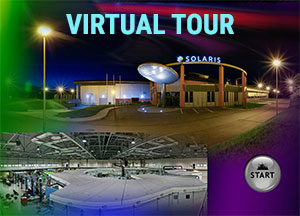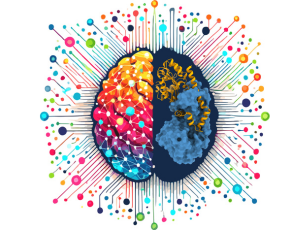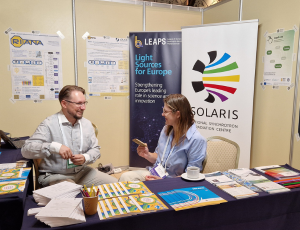 Web Content Display
Web Content Display
SOLARIS centre
 Web Content Display
Web Content Display
Summary of the year 2023
In 2023, the SOLARIS National Synchrotron Radiation Center continued its dynamic growth, adding to its global catalog of scientific publications and expanding new experimental lines. Significant advances in technology, cooperation with international partners and numerous research projects have made SOLARIS a central hub for the European scientific community. Here is a concise summary of the key events and accomplishments that distinguished the center's activities in the past year.
First: research infrastructure and accelerators
The year 2023 was incredibly intense and very important in terms of developing the Centre's research infrastructure. In addition to the implementation of exceptional scientific projects using the available SOLARIS infrastructure, we were able to secure funding for the construction of more lines and new research stations, including the SOLCRYS and SMAUG beamlines under construction. At the same time, two investment projects were completed, with which the CIRI and POLYX beamlines were made available for the first time to call for proposals.SOLARIS has also demonstrated in the field of reliability in providing a photon beam with nominal parameters for users of the beamlines. In 2023, the total time scheduled for beam operation was 4038 h. Source availability was achieved at 97.4%, which is a huge success. The Centre also continually worked on improvements to the radiation source. Among the most important achievements in 2023 was the launch of the fast orbit correction system, which is designed to offset the impact of photon beam disturbances caused by the movements of the insertion devices. In addition, a dedicated vacuum chamber system was installed, tested and commissioned in the circular gas pedal, along with a mirror chamber for infrared radiation extraction. In September, we were able to observe the first light that will be used for research on the CIRI beamline.
On a center-wide scale, an undisputed milestone this year was the completion of the expansion of the synchrotron's experimental hall. The enlarged building will primarily enable four more beamlines, including SOLCRYS and SMAUG. The cryomicroscopy laboratory will also find its place in the new hall. So far, two electron microscopes, Titan Krios and Glacios, stand in purpose-built rooms in the loading dock of the old part of the building. A laboratory will be built within the enlarged hall to accommodate as many as four microscopes eventually. The project also includes a sample preparation laboratory, which will be made available to all SOLARIS users. It will contain the necessary equipment for preparing samples for beamlines and for developing grids for Cryo-EM measurements. The final area that will find its place in the expanded hall is workshop space and new offices for the growing SOLARIS team.
Second: users and research
In parallel with the continued infrastructural development, in 2023 we have seen very effective activities in the field of scientific publications by SOLARIS users and employees, where many of the articles have been published in journals with very high citation rates. Among the nearly seventy new publications, the most noteworthy is an article from research on cryomicroscopy, published in the journal "Nature Communications," in which scientists from the Malopolska Center for Biotechnology at Jagiellonian University revealed the effect of a specific modification on the translation process. Also worth mentioning is an article in Scientific Reports, which describes a study conducted on the ASTRA line. A group of researchers under the scientific direction of Marta Prześniak-Welenc, PhD, from the Institute of Nanotechnology and Materials Engineering, Gdansk University of Technology, conducted research on efficient water purification through solar energy. The SOLARIS team also worked on interesting research. Scientists from the CIRI research line created the first infrared-based machine learning model for complex pancreatic histopathology. The findings were published in the International Journal of Medical Sciences.Noteworthy is the ever-increasing interest in SOLARIS infrastructure. In 2023, we received a record number of requests for beamtime, with several hundred projects receiving positive recommendations and the proposed experiments being implemented in the coming months. In 2023, two open calls for proposals were conducted. Both of which were supplemented with the CERIC-ERIC system. The International Evaluation Committee had the opportunity to analyze a record breaking number of applications submitted for 7 beamlines and cryomicroscopes. In the eleventh and twelfth round of applications for research time on the SOLARIS infrastructure, 333 applications were received, which constitutes a significant increase in the number of research groups interested in measurements compared to the previous year, by as much as 71%. During the winter open call, the CIRI beamline, using infrared radiation for advanced microscopic experiments, was made available for the first time in the competition procedurę and received 11 applications. Another line opened during the winter recruitment is the POLYX beamline for microimaging and X-ray microspectroscopy. Exactly 11 applications were submitted for research time on this beamline. The PIRX, URANOS, PHELIX, DEMETER, ASTRA beamline and cryomicroscope were the subject of 10, 18, 12, 27, 53 and 27 applications, respectively. It is also worth mentioning that in 2023 SOLARIS exceeded the level of PLN 380,000 in revenue from the provision of research infrastructure and commercial service activities.
An important and noteworthy change that was made in 2023 was the refresh of the user support system in the form of a rebranding to a new version under the name SUN (Synchrotron User Network). The changes also included the implementation of new functionalities, such as adding in the system and enabling research time requests for the POLYX beamline, adding new measurement modes for the ASTRA and URANOS beamlines, introducing a new terminal station for the CIRI beamline, and enabling CERIC requests to be entered into SUN to take place on more than one beamline.
Third: consortia and international projects
SOLARIS has invariably conducted multifaceted collaborations with a number of international entities. Among them were consortia bringing together European synchrotron centers (LEAPS - League of European Accelerator-based Photon Sources), specialized laboratories (CERIC - The Central European Research Infrastructure Consortium), as well as intercontinental Internet platforms (Lightsources.org and Wayforlight.eu). As part of its ongoing activities, the Center represented Polish science at the largest research infrastructure organizations. In December 2023, the General Assembly of LEAPS appointed the Director of the SOLARIS Center to be a member of the Board of Directors in 2024-2026, while in 2025 it will be Dr. Jakub Szlachetko, Prof. of the Jagiellonian University, who will give direction to the LEAPS consortium.
Also, the plane of international projects was the site of a number of successes involving the Center. In 2023, SOLARIS was notified of funding for two new European projects - NEPHEWS and RIANA.
- NEutrons and PHotons Elevating Worldwide Science - NEPHEWS is a project that integrate together two European Users Organizations, ESUO and ENSA, with two largest and most advanced consortia LEAPS and LENS. The idea of this project is to develop a new way of cooperation, where neutron facilities works side by side with LEAPS Infrastructures. Additionally, NEPHEWS will give a voice to users through a pioneering User-to-User approach, providing ESUO and ENSA with a leading role in the development of the project. The total value of the project is 4 757 246 EUR.
- Research Infrastructure Access in NAnoscience & nanotechnology - RIANA is a project that provides access to world-class research infrastructures for a wide range of international academic users as well as industry. SOLARIS, through its participation in the project, has declared its willingness to cooperate with the users and will provide beamtime for them as well as support in the implementation of measurements on 4 beamlines, i.e. DEMETER, PHELIX, URANOS, CIRI. The total value of the project is 14,496,952 EUR.
...last but not least: multifaceted popularization of science
The SOLARIS Centre has continuously undertaken the organization of new ventures in the context of popularizing not only the synchrotron and cryomicroscopy, but also the sciences more broadly. Among these are the organization of scientific and popular science events, guided tours, media-relations activities, campaigns in new media, the establishment of permanent forms of cooperation with other units, and activities providing information access for people with disabilities. SOLARIS was involved in 16 special events of various sizes. Among them were a number of scientific conferences (Light for Ukraine and User Meeting), symposia, workshops and seminars. In addition, workshops for young people, experimental demonstrations for children, meetings summarizing international projects and guest speakers from scientists from other centers. Among the initiatives aimed at the public, the most important was invariably the Night of Scientists, which in 2023 reached a university record of interest - SOLARIS presented a variety of attractions to more than 1,200 people.
Among the Centre's core activities was the SOLARIS tour organization, which underwent a major makeover this year.
The SOLARIS, understanding its potential to popularize science, organized free-of-charge group tours around the Centre. The guided tour of SOLARIS is based on a professional scenario using a variety of (including multimedia) tools. It is an excellent form of popularizing various fields of science and complementing the didactic process at all levels of education. It gives visitors access to advanced technologies, educates in science, inspires future and current scientists, connects the fields of theoretical sciences with reality, and awakens curiosity and interest in scientific research. A visit to the Centre provides an opportunity to get acquainted with the center's subject matter, to explain the key physical phenomena and the most important research results. The goal of visiting SOLARIS is to unleash the potential resulting from observing the country's largest research tool.
In terms of tours, 2023 was a special time - the infrastructure of the Center was visited by 2,400 people. This is more than 600 more people than the year before (and this despite the ongoing expansion of the hall). The SOLARIS Knowledge Path based on the audio guide system was opened for testing in the fall of 2023. As of November 1, the Center was visited over by 200 people who used the audio guides.
The past year, once again, can be counted as a period with an upward trend in the popularity of the SOLARIS Center's social media channels. The total number of followers on SOLARIS social media channels included 4250 followers in December 2023. This is an increase of 1216 followers, compared to the previous year, or 40.06%. Care is taken to maintain constant communication with the audience of articles on research and events carried out at SOLARIS, not only on the level of new media. The tongue in cheek is the relationship with journalists of traditional channels such as radio, television and magazines. In 2023, SOLARIS was subject of over 50 press reports. This year also saw the development of excerpts from the most important research conducted at the Centre, the result of which was the publication of 32 so-called highlights.
The summary was written in collaboration with Dr. Jakub Szlachetko, Dr. Adriana Wawrzyniak, Ireneusz Zadworny and Michał Młynarczyk.
Published date 04/01/2024
- Agnieszka Cudek
Recommended



